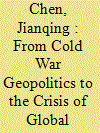| Srl | Item |
| 1 |
ID:
192625


|
|
|
|
|
| Summary/Abstract |
This paper explores the genesis and growth of the current Chinese wireless network infrastructures by pulling together the historical threads of two telecommunications infrastructures: first, the development of the first-tier inter-provincial optical backbone, the “Eight Vertical and Eight Horizontal Fibre-optic Grid,” in the late 1980s and 1990s; and second, the deployment of two broadband-access cellular networks, the third-generation (3G) cellular networks in 2008 and the fourth-generation (4G) networks from 2013 to now, which constitute the wireless network's edges. I insert the development of Chinese wireless networks since the 1980s into the interconnected global technological environment, contextualizing the infrastructure deployment in the history of Sino-American technological cooperation and competition, traversing the final decade of the Cold War era (the 1980s), the dual global expansion of economic neoliberalism and informational technology since the 1990s and the crisis of global capitalism since 2008. This historical inquiry reconciles two historical (meta-)narratives that are not always compatible with each other – the Chinese narratives grounded on the overarching concept of Chinese post-socialism, and the narratives in Western discourses that often evoke Cold War/post-Cold War dialectics. This paper examines the global distribution of wireless network infrastructures on the basis of commercialization, technology transfers and trades of techno-commodities across borders, challenging the reduced depiction of the Chinese wireless network as an extension, or an exception, to the West-centred techno-capitalist system.
|
|
|
|
|
|
|
|
|
|
|
|
|
|
|
|
| 2 |
ID:
193618


|
|
|
|
|
| Summary/Abstract |
Focusing on soy sauce exports from Hong Kong to the United States, this article traces the origin of the ‘Made in Hong Kong’ label to the US-led embargo on Chinese goods during the Korean War and explores the repercussions the recent Sino-US conflict generated on the label. By examining the history of an enterprise embroiled in two episodes of global trade disruptions, this article reveals how politically motivated US trade policies steered businesses in Hong Kong to pursue commercial opportunities by leveraging geopolitics, both global and local. Strategically capitalizing on Hong Kong’s position during the Cold War that allowed local exports to the United States, Hong Kong entrepreneurs created an international product chain. When the latest Sino-US trade war erupted, Trump’s elimination of the distinction between China-made and Hong Kong-made exports coincided with a wave of local consumerism in Hong Kong and unintentionally imbued meaning into homegrown products. From a commercially expedient marker aimed at satisfying the US government’s anti-China trade requirements, the ‘Made in Hong Kong’ label has recently been repurposed as a badge of local pride and perseverance as Hong Kong/mainland tension escalated. Necessitated by global trade policies and infused with connotations of shifting geopolitics, the malleable ‘Made in Hong Kong’ label signified not only reactions to US policies but also fluid Hong Kong/China relations. In successive rounds of US-initiated trade disruptions, the place-of-origin label reflected Hong Kong’s changing place in global geopolitics and the city’s position vis-à-vis the PRC.
|
|
|
|
|
|
|
|
|
|
|
|
|
|
|
|